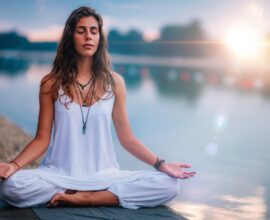Ashtanga Yoga: meaning, origin and benefits
Ashtanga Yoga: the dynamic yoga of “8 steps”
The time dedicated to rest and cure of oneself is fundamental for a psychophysical balance. With Ashtanga Yoga, one of the many yoga styles, it’s possible to relax the mind and learn how to listen to ones body so to find an inner harmony which is put to the test by daily routines.
At home or on vacation, maybe in front of the beautiful Sardinian sea, doing yoga everyday is a good habit and among the many different styles of this discipline, born in India about 5000 years ago, Ashtanga Yoga is perfect for those wanting to strengthen their muscles, improve their posture and the flexibility of their spine.
Ashtanga Vinyasa yoga, know more simply as Ashtanga Yoga, comes from Hatha yoga, the most ancient and traditional form, also the most popular in Western civilization. It’s a dynamic, vigorous and quite hard work practice, that concentrates on the coordination of postures (asana), the correct breathing (ujjay pranayama) and sight (drishti). In this particular yoga practice, also called “meditation in movement”, the asanas are performed in a way to create a continuous flow, they are joined between each other with transitional movements (vinyasa) and connected with breath and sight.
The word ashtanga means “eight levels” with reference to 8 steps described by Indian Philosopher Patanjali, in the Yoga Sūtra, and ancient philosophical text considered a mile stone in darśana Yoga. Here are the 8 steps that every yoga practitioner (yogi) should do so to achieve control of their mind and self consciousness:
- Yama (ethnic discipline / the actions we do toward others)
- Nyama (obligation / the actions we perform for others)
- Asana (posture / positions)
- Pranayama (breath control)
- Pratyahara (control of the senses)
- Dharana (concentration )
- Dhyana (meditation)
- Samadhi (contemplation / awakening / liberation)
The eight levels make a course which every practitioner needs to do and are interconnected. Asanas, for example, depend on the correct execution of pranayama which also influences Yama and nyama, meanwhile the first four levels are physical actions needed for the development of the four more spiritual ones to follow.
The main characteristic of Ashtanga Yoga is hidden in the name vinyasa, which means “system of breath in movement”, a series of rules explaining why breath is at the center of yogic discipline:
- Each asana corresponds to a precise number of breaths
- Performing Mule-bandha and Uddyana (closures) and synchronizing the movement with breath, we produce inner warmth necessary to purify the muscles and organs.
- vinyasa is the connection between an Asana and an asana within a certain series.
- vinyasa regulates the breath and improves blood circulation
- The vinyasa system strengthens the body, making it lighter.
- Breathing must be rhythmic, the body strong and the mind calm.
Ashtanga Yoga: brief history of the founder and the six fundamental postures
Shri K. Pattabhi Jois is the father of Ashtanga Yoga and one the first yoga master who contributed to spreading the discipline in the Western world during the 20th century.
He was born on the 26th of July 1915 in Kowshika, a small village in the south of India. Pattabhi Jois was the son of a local astrologist and priest, he began to be interested in Veda, ancients sacred Indian texts when he was five years old. When he was 12 he assisted his first yoga lesson in middle school and the following day, fascinated by the discipline, he decided to meet Sri T. Krishnamacharya, a yogi who has exhibited during the demonstration and then became his master.
Pattabhi Jois has dedicated his entire life to teaching a discipline that requires physical effort, sweat and determination, performed in the morning during the early hours of the day, 6 days a week, excluding Saturdays. This practice is not suitable during days with a full moon or new moon, during the first three months of pregnancy or for 40 days after giving birth.
Ashtanga Yoga has 3 series, each more intense and difficult than the previous:
- Yoga Chikitsa: including 75 asana and has the objective of detoxifying the body and realigning the spine
- Nadi Sodhana is focused on the nervous system and opening energy channels
- Stira Bhagah Sampta needs a good dose of strength and humility in order to reach a state of grace
There are 4 variations of the last series, for a total of six sequences which have the power of detoxifying the body and make it stronger and lighter, eliminating impurities and toxins though sweat.
Would you like to do Ashtanga Yoga in a true paradise and have an unforgettable vacation? Discover Forte Village Resort in Sardinia.






